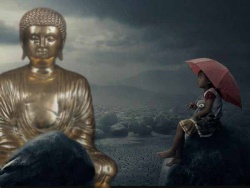Vijnaptimatratasiddhi
Contributions of Vasubandhu and Asanga
Converted by his brother Asanga to the Yogachara, Vasubandhu wrote the Vijnapti-matrata-siddhi (“Establishment of the Thesis of Cognitions—Only”), in which he defended the thesis that the supposedly external objects are merely mental conceptions. Yogachara idealism is a logical development of Sautrantika representationism: the conception of a merely inferred...
Vijnaptimatratasiddhi shastra (Treatise on the Establishment of the Doctrine of Mere Consciousness) ( ),
10 fasciles translated in 659 A.D. * Mahayanabhidharma samucchaya (collection of the Mahayana Abhidharma]]) ( ),
7 fasciles in 652 A.D. * Mahayanabhidharma samucchaya vyakhya (Exeglsis on the collection of the Mahayana Abhidhin),
16 fasciles in 646 A.D. * Mahayanasamgraha (comprehensive Treatise on Mahayana Buddhism) ( ), 3 fasciles in 648-649 A.D.
Hsuan tsang was born into a family of scholars near Loyang ( ), but his father did not want to serve the new king, then became poor.
In order to make a living, Tsuan tsang followed the step of his elder brother to become ordained monk when he was a child.
However, when he was eleven, he was able to read the Vinmalakirti Sutra, the Lotus Sutra, etc.
He was brought up at Hui jih Temple in Loyang. Later, he went to Chuang yen Temple in Chang an in search of better teachers, but in vain.
Because of famine, Tsuan tsang settled in Szechuan Province and continued his study in Buddhism. He kept on seeking for better teachers, but found no more outstanding scholars.
In 629, when Hsuan tsang was around thirty, he set out to the west for travel and study. In his travels, he had recorded all his experience in India and Central Asia in details, which had important information on geography, history, politics, economics, culture of that time.
Hsuen Tsang A painting from a Chinese Monastery. Courtesy: D. Mitra, Buddhist Monuments.
A well known Chinese monk who visited India and traversed a large number of countries covering more than 50,000 Li.
Though the dangers that he encountered were many he fulfilled his main objective undaunted by them.
His contribution to the cause of Buddhism in general and to the Great Vehicle in particular is immense.
For these and many other reasons he is held by the Chinese Buddhists in the highest esteem among the pilgrims of his caliber.
The following information on Hsuan tsangs travels and his accounts of India and other countries which he traveled in his long journey is based mainly on two sources, namely, Si yu ki, Buddhist Records of the Western World an English translation of the Chinese version of Hsuan tsang and The Life of Hiuen tsiang an English translation of his biography written in Chinese by Shaman Hwui li, a disciple of his.
Among secondary sources the most useful treatise is On Yuan Chwangs Travels in India, a critical study written by Thomas Watters in 1961.
This work is based on Hsuan tsangs Hsi Yu Shi (or Si Yu Ki) also entitled Buddhist Records of the Western World.
Hsuan tsang was born in 603 A.C. in Chin lu in the reign of Emperor Wen of the Sui dynasty and lived about sixty five years.
Opinions, however, differ regarding the exact years of his birth and death.
His secular name was Chen Chin and he was the youngest of four brothers.
His father was Chen hui who devoted himself to the study of Confucious teachings.
Even as a child Hsuan tsang was unusually of grave temperament and intelligence.
He did not enjoy the company of boys of his age nor did he appreciate their life style.
His second brother, Chang tse who had entered the Order previously took Hsuan tsang to his own convent and made arrangements to impart instruction to him there.
Hsuan tsang (= Ht.) was so studious that at times he studied without sleep and even food.
At one hearing he is said to have comprehended a book thoroughly and after a second reading needed no further instruction.
At the age of eleven he was versed in the Saddharmapundarika Sutra and the Vimalakirtinirdesa.
At the age of thirteen he was admitted into the Order and was engaged in further studies.
The political situation in the country being unsatisfactory the two brothers went to Changan and from there again to Cheng tu, the capital of Shu.
There Hsuan tsang followed lectures on the scriptures delivered by eminent scholars and in a few years he mastered the scriptures of various schools and earned a name as a scholar.
It was about this time or a few years later that he came to be known by the appellation The Master of the Law.
In the fifth year of Wu te he received full ordination at Cheng tu.
